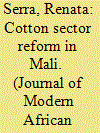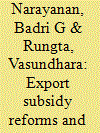| Srl | Item |
| 1 |
ID:
133614


|
|
|
|
|
| Publication |
2014.
|
| Summary/Abstract |
This paper provides a detailed analysis of the cotton sector reform process in Mali from 2000 to 2011, explaining reform delays and ambiguities in terms of the wider political and socio-economic context and aid relationships. Contrary to arguments pointing to lack of state commitment and ownership, domestic stakeholders increasingly worked towards finding an acceptable and consensual reform package. The process encountered quite serious obstacles, however, due to divergent actors' incentives, and the existence of opposing philosophies about what a restructured cotton sector should look like. As a consequence of donors' misjudgement of the political and social realities underlying the Malian cotton sector, dialogue among stakeholders was difficult and polarised, forcing the government to spend considerable time and resources to find a suitable compromise. This paper contributes to a better understanding of the merits and limits of pursuing consensual policy processes against the constraints posed by divergent donors' policy paradigms.
|
|
|
|
|
|
|
|
|
|
|
|
|
|
|
|
| 2 |
ID:
133886


|
|
|
|
|
| Publication |
2014.
|
| Summary/Abstract |
The World Trade Organization (WTO) recommends all members to phase out their export subsidies. While this may render export-oriented industries susceptible to tighter competition in their import markets, productivity improvements could help offset such disadvantages. This article explores the interaction between these two different aspects to evaluate the economy-wide impact of export subsidy reforms and productivity improvements in the Indian textile and clothing sector. Our analysis stands on various policy simulations applying the general equilibrium model of the Global Trade Analysis Project (GTAP; Hertel, 1997). The welfare impacts of the removal of Indian textile and clothing subsidies in terms of equivalent variation shows that India is expected to encounter a loss of about 71.5 million US$, while other Asian countries may gain about 218 million US$. In a different scenario, we simulate the impact of a complete phase-out of subsidies provided to the textile and clothing industry of India and a simultaneous increase in total factor productivity growth to 3.5 per cent. This leads to a net positive welfare change and an expected gain of about US$ 13.17 million in terms of allocative efficiency. We conclude that merely removing subsidies is not enough, as is often argued by Indian policymakers that such a policy reversal might result in contraction of the sector. Investments in total factor productivity should come about simultaneously, probably by employing surplus funds from saved subsidy payments in areas like research and development and infrastructure. This conclusion may be qualitatively generalised for any sector in the world, which is examined for export subsidy reforms, but similar economy-wide studies are recommended for specific cases.
|
|
|
|
|
|
|
|
|
|
|
|
|
|
|
|